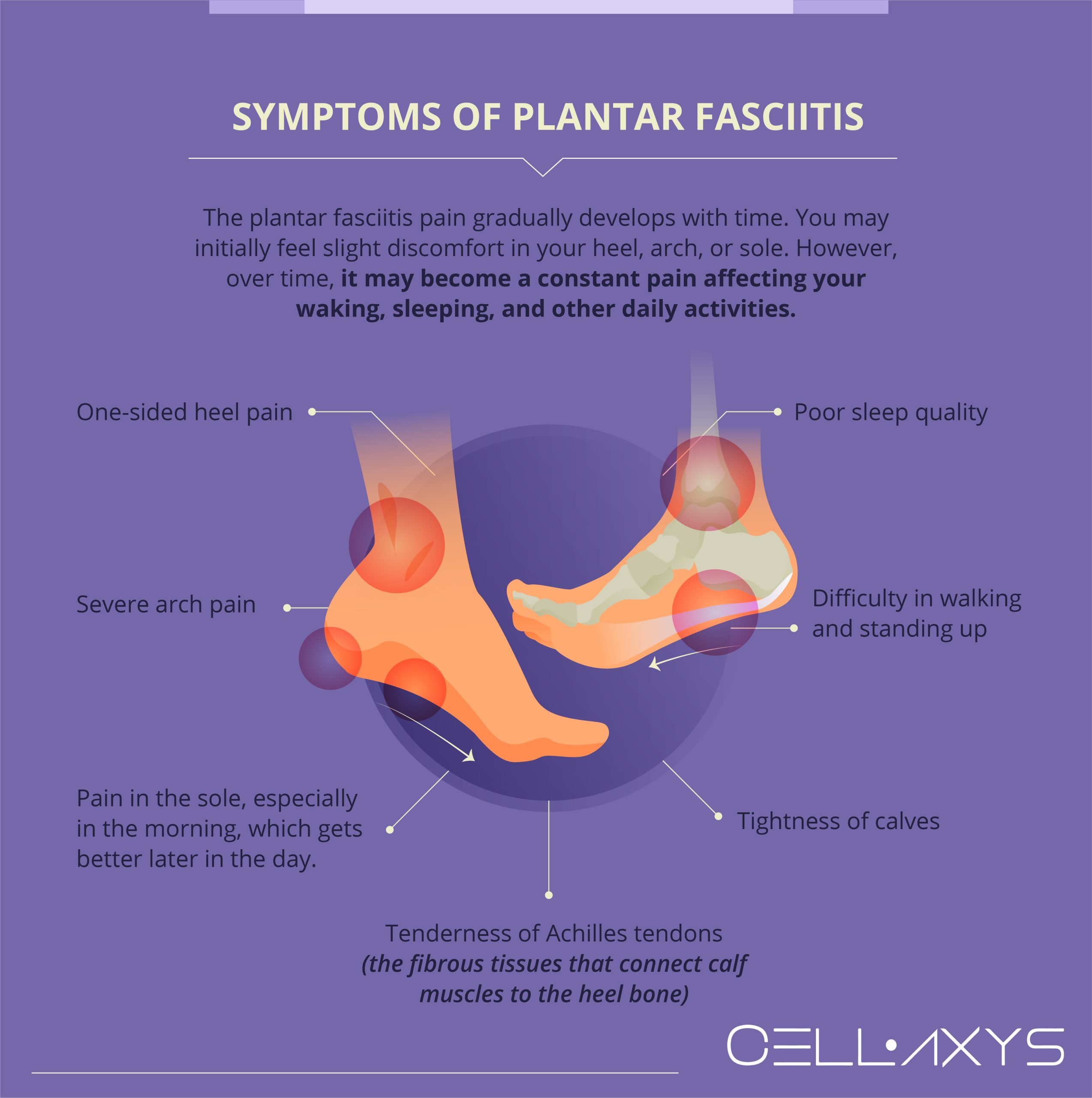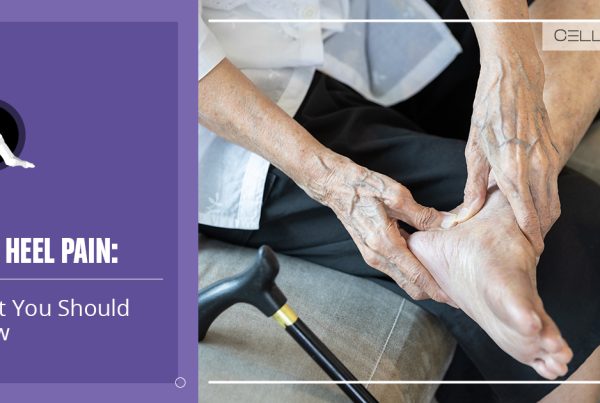Published on: December 21, 2022 | Updated on: January 18, 2025
You may have plantar fasciitis if your mild heel pain suddenly becomes unbearable. It is a condition that makes the soles of your foot swollen and painful. The inflamed foot fascia identifies the pain, the band of connective tissues beneath the skin that stabilize muscles and other internal organs.
The plantar fasciitis pain can be so intense that you won’t be able to stand up, walk, or even fall asleep. Without treatment, plantar fasciitis can aggravate and affect your daily life activities. The condition is common among athletes and people who regularly walk on hard surfaces.
Conservative treatments, such as rest, physical therapy, and medications, can help with plantar fasciitis pain. However, the treatment isn’t always practical. In such a situation, doctors suggest surgery and orthobiologic treatments.
Plantar Fasciitis: A Brief Overview
Plantar fasciitis affects the connective tissues of your heel that support, stabilize, and protect the foot, called fascia. The fascia is a thick band extending from your heel bone to the toes and consists of three bands: medial, central, and lateral.
Plantar fasciitis is a common cause of severe heel pain among Americans. According to an estimate, it affects 2 million people in the country every year. Those aged between 18 and 44 are less likely to have this condition than those aged 45 to 64.
Symptoms of Plantar Fasciitis

The plantar fasciitis pain gradually develops with time. You may initially feel slight discomfort in your heel, arch, or sole. However, over time, it may become a constant pain affecting your waking, sleeping, and other daily activities.
Some common symptoms of plantar fasciitis include:
- One-sided heel pain
- Severe arch pain
- Pain in the sole, especially in the morning, gets better later in the day.
- Tenderness of Achilles tendons (the fibrous tissues that connect calf muscles to the heel bone)
- Tightness of calves
- Difficulty in walking and standing up
- Poor sleep quality
Causes of Plantar Fasciitis
The causes of plantar fasciitis can be anatomical, mechanical, or environmental. The most common ones include the following:
- Obesity
- Flat or extremely high-arched feet
- Shortened Achilles tendon
- Overpronation (inward rotation) of the feet
- Restricted ankle movement
- Weak foot muscles
- Asymmetrical leg length
- Deconditioning
- Prolonged standing
Remember, not all types of heel pain are plantar fasciitis. You may feel pain in the heel because of the following:
- Heel fracture
- Foot arthritis
- Tibial nerve compression, also called Tarsal Tunnel Syndrome
- Neuropathy due to medical conditions, such as diabetes
- Achilles tendonitis
- Posterior tibial tendonitis
- Disc injury or spinal stenosis
- Heel spur
- Bone infection (Osteomyelitis)
Treatment Options for Plantar Fasciitis
Plantar fasciitis is not a simple inflammation in your feet that can be easily treated. Instead, it is a chronic degeneration and tearing of your heel’s connective tissues, which is a severe condition.
Depending on the severity of your plantar fasciitis, the doctor will choose the right treatment option. Generally, conservative care is the first line of treatment in such situations. But if it doesn’t work, the doctor may opt for surgery or other options.
Conservative Care
The first-hand treatment for plantar fasciitis includes:
- Rest
- Anti-inflammatory medications containing fish oil and turmeric
- Stretching and other physical exercises
- Appropriate orthotics, night splints, and shoes
- Physical therapy
- Steroid injections, in case other methods fail. However, they can cause tissue or cartilage damage.
- Partial Plantar Fasciotomy is a surgery that cuts a small part of the plantar fascia. But it isn’t recommended as cutting the fascia won’t solve the problem, which is degeneration and micro-tearing. Instead, it will weaken your foot structure and cause more foot pain.
Orthobiologic Methods
If conservative care doesn’t give you the desired results, you can get help from regenerative medicine, or what we call today the orthobiologic treatments. They primarily include two methods: cell-based or stem cell therapies and platelet-rich plasma (PRP) therapy.
Many people complaining about “plantar fasciitis so bad I can’t walk” rely on any of these methods as they are less invasive and painful. The doctor harvests autologous or the patient’s healthy tissues from one part and injects them into the injury site to promote healing and early recovery.
At CELLAXYS, we offer both orthobiologic treatments, depending on each patient’s foot condition.
Cell-based Therapies
Also popular as stem cell therapies, this process takes healthy cells from two parts of the patient’s body, processes them, and reinjects them into the injury site. The doctor will first assess your foot’s condition and will recommend one of the two types of cell-based therapies:
- Minimally Manipulated Adipose Tissue Transplant (MMAT). The process extracts healthy cells from your adipose (fat) tissue and reinjects them into the injury site to promote healing. The good thing about MMAT is that the doctor can perform it in multiple areas in the same procedure.
- Bone Marrow Concentrate (BMAC). It takes highly concentrated cells from your bone marrow and reinjects them into the injury site.
Both MMAT and BMAC can be completed within 1.5 to 2 hours. They are outpatient procedures, meaning you can go home right after the process.
Platelet-Rich Plasma Therapy (PRP)
PRP involves drawing the patient’s blood sample, isolating platelets, processing them, and reinjecting them into the patient’s injury site. Platelets are the healing components of our body that serve as the first line of defense against injuries. They perform three essential functions to promote healing in your inflamed foot.
First, platelets release 10 Growth Factors that promote new tissue development. Second, they attract healing cells from the blood. Third, they produce a web-like scaffolding called fibrin that encourages new cells and tissues. A high number of platelets in the injury site promotes early recovery.
PRP has been a popular treatment for spine, orthopedic, and sports-related injuries. It is also an outpatient procedure and is completed within 45 minutes.
In cell-based therapies and PRP, the doctor uses live X-rays and ultrasounds to detect the exact location of the injury on your foot. Both therapies treat the pain in the foot and its underlying cause, offering long-lasting and more effective results than conservative care.
Sources
Footnotes
- Kim W, Voloshin AS. Role of plantar fascia in the load bearing capacity of the human foot. Journal of biomechanics. 1995;28(9):1025-33.
- Schwartz EN, Su J. Plantar fasciitis: a concise review. The Permanente Journal. 2014;18(1):e105-7.
- Blake RL, Anderson K, Ferguson H. Posterior tibial tendinitis. A literature review with case reports. Journal of the American Podiatric Medical Association. 1994;84(3):141-9.
- Marafkó C. Endoscopic partial plantar fasciotomy as a treatment alternative in plantar fasciitis. Acta Chirurgiae Orthopaedicae et Traumatologiae Cechoslovaca. 2007;74(6):406-9.
- Young CC, Rutherford DS, Niedfeldt MW. Treatment of plantar fasciitis. American family physician. 2001;63(3):467-75.
References
- Plantar fasciitis. NHS. Accessed 9/7/2023.
- Plantar fasciitis. Mayo Clinic. Accessed 9/7/2023.
- When Plantar Fasciitis Is So Bad You Can’t Walk. Verywell Health. Accessed 9/7/2023.
CELLAXYS does not offer Stem Cell Therapy as a cure for any medical condition. No statements or treatments presented by Cellaxys have been evaluated or approved by the Food and Drug Administration (FDA). This site contains no medical advice. All statements and opinions are provided for educational and informational purposes only.
Dr Pejman Bady
Author
Dr. Pejman Bady began his career over 20 years ago in Family/Emergency Medicine, working in fast-paced emergency departments in Nevada and Kansas. He has served the people of Las Vegas as a physician for over two decades. Throughout this time, he has been met with much acclaim and is now the head of Emergency Medical Services in Nye County, Nevada. More about the doctor on this page.
Dr Pouya Mohajer
Contributor
Pouya Mohajer, M.D. is the Director of Spine and Interventional Medicine for CELLAXYS: Age, Regenerative, and Interventional Medicine Centers. He has over 20 years of experience in pain management, perioperative medicine, and anesthesiology. Dr. Mohajer founded and is the Medical Director of Southern Nevada Pain Specialists and PRIMMED Clinics. He has dedicated his career to surgical innovation and scientific advancement. More about the doctor on this page.









